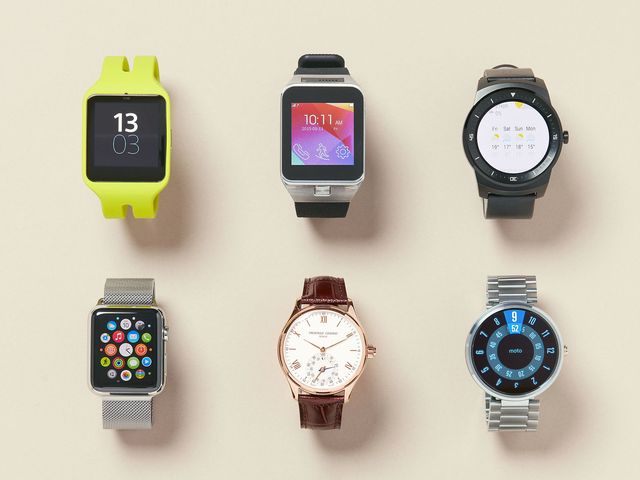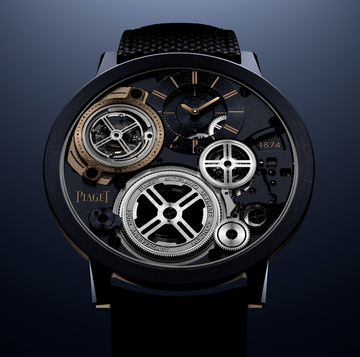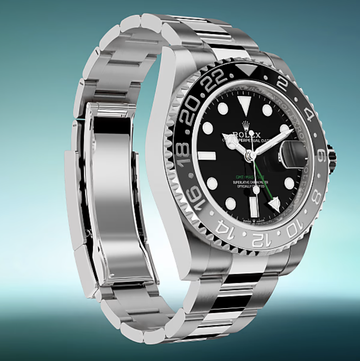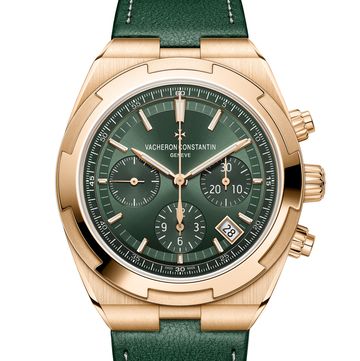The hands of time are moving in mysterious ways. To be precise, they're moving in opposite directions at once. The hour and minute hands of the reassuringly heavy, stainless-steel Frédérique Constant Horological Smartwatch that I'm holding — plus the two smaller hands on a secondary dial at the bottom of the watch face — are gliding into new positions of their own accord, no winding adjustment necessary. It's sort of mesmerising. This watch is doing something that watches seldom do. It's syncing.
Specifically, it is communicating, via Bluetooth, with a companion app called MotionX-365. The app lives on an iPhone belonging to Peter Stas, CEO and co-founder of Frédérique Constant, the Geneva-based watch brand that styles itself as "accessible luxury".
The watch is telling the phone how many steps its wearer has taken today and what his sleep patterns were last night. And, in turn, the app is telling the watch what time zone we're in (Central European Summer Time; we're meeting in Geneva's watchmaking suburb of Plan-les-Ouates) in order to adjust its hands accordingly.
Stored in the Cloud and crunched into graphs, the data will give Stas a picture of his activity, much as any fitness band might, except that the device on his wrist looks nothing like an anonymous plastic bracelet — nor any other smartwatch for that matter. It's substantial and masculine, all brushed steel and silver Roman numerals. Most smartwatches resemble geek toys, cheap gimmicks, the latest iteration of the electronic devices that increasingly define our world.
Frédérique Constant's looks like a watch from another time — the sort your grandfather might hand down to you.
"It's beautiful, isn't it?" says Stas, a Dutchman who left a career in product management at Philips in 1992 to work full-time on the watch company he founded with his wife Aletta in 1988. Stas is gambling that a synthesis of traditional Swiss craftsmanship and new technology will open up a lucrative future for high-end watchmaking. But he's also right. His smartwatch is, objectively, a beautiful thing that does useful stuff. The question is whether that combination will be enough to safeguard Swiss luxury watchmaking from the digital upstarts at its gate. Which means, of course, the Apple Watch.
There was a perceptible sense of relief when I spoke to Swiss watch-industry executives over the summer. By the sound of things, they felt they'd collectively dodged a bullet. The Apple Watch had turned out to be, well, not all that. When Apple CEO Tim Cook announced the new device in September 2014, he sent the watch industry into a barely concealed panic.
Here was a potential repeat of the "quartz crisis" of the early Seventies, when cheap electronic watches from the Far East, which kept time according to the supernaturally accurate vibration of quartz under an electric current, rendered traditional mechanical watch mechanisms — movements — redundant.
The Swiss watch industry had ignored quartz and the advent of inexpensive digital watches and had paid dearly for its complacency. Ultimately, Swiss watchmaking would take until the 21st century to fully redefine itself, and to recreate its product as an expression of wealth and taste. By which time, the world's most dominant electronics company would be thinking about wearables and, specifically, a watch.
The Apple Watch was a worldwide news story. At the Baselworld international watch fair in March 2015, the talk was that the mass-market timepieces of the future would either be smart — or they'd become extinct. "There's a sense that the world is now connected, and tomorrow every watch will need to be connected," says André Bernheim, CEO of the Swiss company Mondaine,
who make a famous — OK, let's say it, iconic — watch modelled on the Swiss SBB railways clock. "The talk was that whoever doesn't fix the connectivity issue is in trouble."
But when Tim Cook came to announce Apple's financial results in July, he gave no specific sales figures for the Watch. Those details were bundled into a nebulous "other" category, along with second-tier devices such as the iPod and Apple TV. Although Cook would later say that the Watch "beat our expectations", this was a conspicuous omission for a company noted for making a big deal of its successes.
It fed into a wider perception that the Watch is Apple's first major misstep: the point at which a company famous for moving into new industries and reinventing them — as the iPod did with music and the iPhone with mobiles — finally overreached itself.
If you've had any experience with the Watch, you might understand Apple's reticence. On the face of it, it's a brilliant idea: a networked timepiece that does everything, aimed at a generation that grew up without the need for a watch, because they were surrounded by clocks on their phones, PCs, TVs and music players. Messages, maps, music and photos all on your wrist — who wouldn't want that?
But after the novelty of texting someone by yelling at your wrist wears off, you find that the Watch doesn't do anything that your phone doesn't do better. In fact, it does too much. The more otiose, gimmicky features (who really wants to share their heartbeat with their significant other or send them a doodle at the office?) made it feel like a grown-up Tamagotchi.
The need to charge it daily becomes irksome. Add in hugely divergent prices for models that contain exactly the same computing power — from £300 for the Sport model to £13,500 for the 18-carat rose-gold edition — and the impression is of a watch designed by people who don't really know about watches.
"The unspoken word is that if Steve Jobs were still alive, the Watch wouldn't have been released," says Peter Stas. "My feeling is that it's going to be a failure. Apple doesn't realise that the reasons for buying a watch are very different from buying a phone or Mac. You don't buy one for the functionality; you buy it for what it says about you, for its design and uniqueness. A real watch is not obsolete after a couple of years — you want to pass it on. We don't all wear the same clothes, so why would we want the same watch?" And he says that Apple broke too many cardinal rules. "Any CEO in this industry will tell you that square faces do not sell to men. So why make an entire line of them?"
The panic during the Baselworld watch fair has since given way to a more sober projection of the future of watchmaking and how it should incorporate new technology. Because, if there's one thing the Swiss have learned in 450 years of making watches, it's that telling the time is only part of what they do.
Much of the manufacture of the Helvetica 1 Smartwatch is done by hand at Mondaine's factory in Solothurn, Switzerland
Today, Swiss watches are so accepted as a mark of quality that we forget how incongruous it is that such an industry should exist at all. Why Switzerland? Why watches? The story goes back to the 16th century, when Calvinist lawmakers banned jewellery in Geneva, forcing the city's jewellers to reskill themselves as makers of pocket watches.
An influx of Protestant Huguenots, fleeing persecution in Catholic France, brought yet more watchmaking expertise to the country. And in the bleak Jura Mountains they discovered a populace accustomed to spending half of the year in semi-darkness, snowed in as winter blocked the mountain passes. Patient and diligent, these rural Swiss proved to be ideal craftsmen, who could produce ever-smaller and more exacting components for increasingly sophisticated watches. (Many of their original practices still persist. Because they had nothing to see by but daylight, watchmakers would work from dawn.
Today, their descendants will often start work at 6am in the summer months for no other reason than it's always been this way.) Over centuries, the Swiss character has seeped into their watches.
"It's like our mountains," says André Bernheim. "They've been here for millions of years and they don't change. Swiss people have inherited some of that: we're consistent. Tradition matters. That's what we sell, not only in watches but in design and architecture. It's not just for the here and now; it's for now and long into the future."
I'm talking to Bernheim in Mondaine's purpose-built factory in Solothurn, halfway between Zurich and Geneva. Opened in 2009, it produces between 500,000 and 700,000 watches a year, using a hybrid of traditional watchmaking and modern, automated methods — Mondaine adopted SAP supply management software after Bernheim visited the Aston Martin factory in the UK. At Solothurn, robots perform the less complicated tasks, placing larger components for the movements into custom trays on conveyor belts. The more delicate arrangements require the human eye. We watch as white-coated women in hairnets use needle-sharp applicators to meticulously place millimetre-wide glass cylinders of luminous gas onto the faces of Luminox watches, the glow-in-the-dark sports brand that comes under Mondaine's umbrella. The attention to detail is hypnotic.
André's father Erwin, a former salesman for the Rado watch company, founded Mondaine in 1951, after establishing himself as a watch dealer to the post-World War II Jewish diaspora. He set up his first factory in a school gym; over the following decades, Mondaine would co-create the first LED and LCD watches, and become major manufacturers of digital timepieces in Switzerland
"My father wanted us to become the Volkswagen of watchmakers," André Bernheim says. "He wanted to offer affordable precision and dependability for everyone. In the time of purely mechanical watches it was too difficult. The movements were too complicated, too expensive and so on. But LED and LCD, and the first quartz digital watches, were a breakthrough for us. There is potential for the same sort of change with smartwatch technology."
Mondaine ceased making digital watches at the end of the Seventies and moved into the analogue quartz market. When the company licensed the official design of the Swiss SBB railways clock in 1986, Mondaine got a second wind. Twenty-five years later, looking for another essentially "Swiss" design idea, they hit upon Helvetica, the ubiquitous sans-serif typeface. Released in 2014, Mondaine's Helvetica No 1 family of watches paid knowing tribute to its typographical roots by coming in "light", "regular" and "bold" versions.
But Bernheim admits that even 12 months ago, smartwatches were far from his mind. "If you'd asked me last year I'd have said no, we are not going to do a smartwatch. It's not what we do," he says. "Our feeling was that electronics products do not have the same emotional factor, the same timelessness as a real, Swiss-made watch."
But in February of this year, six weeks before Baselworld, he and his brother Ronnie got a message from Peter Stas of Frédérique Constant. "Peter said, 'I think I have something exciting for you' — and he was right," says Bernheim. Stas showed Mondaine the MotionX smartwatch technology that his company had developed with software company Fullpower. "We were very interested," says Bernheim. "This was not just a collection of unrelated functions that any mobile phone could perform better. These were carefully chosen functions, which only made sense within a watch — functions that need to be on your body, to gather data, in order to add value to your life.
Mondaine managed to announce a smartwatch version of its Helvetica line — featuring a licensed version of the same tech that's inside Frédérique Constant's Horological Smartwatch — within weeks. They had it ready in time for the Basel expo, where a female journalist quizzed Bernheim about the sleep-activity function: "Does the watch record all your activity in bed?" Bernheim had to dodge that one.
Now the Helvetica 1 Smartwatch is on sale, first in a limited edition of 1,957 (the year that Swiss typographer Max Miedinger developed Helvetica) at a cost of £540, and then on general release.
"We think that there are some very simple advantages to this technology that will make it very attractive to consumers," says Bernheim. "It does not try to do everything. It doesn't bring you your text messages or tell you the weather. Your phone can do that, and can do it better on a large display. You don't need to charge it every night — it has a battery life of two years, as you'd expect of a luxury watch. And the most important thing is, it feels like a real Swiss-made watch with analogue hands and a date. Even if you don't use the additional functions for a few days, it is still a beautiful watch, a real watch."
Bernheim hands me his own Helvetica 1 Smartwatch. It's a pleasingly hefty piece, its thick body and leather strap projecting confidence and solidity. But it's the watch face that really makes sense of it as both a smartwatch and a work of design. Helvetica's calm authority and the watch's subtle connected features both flow from the same design philosophy: beauty arises when form follows function.
Mondaine plan to sell the watch direct to design-conscious customers via New York's Museum of Modern Art and the typeface foundry Monotype. It is undeniably a gorgeous and highly desirable item. Other smartwatches, especially at the cheaper end, strive to look like devices from the future; this one feels like it comes from outside time.
The Frédérique Constant Horological Smartwatch being assembled in Plan-les-Ouates, near Geneva
Frédérique Constant's aesthetic comes from a different and perhaps more familiar place: the carefree glamour of pre-war Europe. On the first floor of its airy, glass-windowed factory in Plan-les-Ouates — where Rolex, Patek Philippe, Harry Winston and many other luxury manufacturers gather in Geneva's "Watchville" — there are display cases showing the company's various collections.
There is the Runabout line, which echoes the sleek look of powerboats; the Worldtimers, with their intricate, engraved time-zone maps; and the Healey line, based on the Austin Healey vintage rally car. Peter Stas admits that Frédérique Constant tends to follow his own tastes. "I'm a classic guy, very Thirties — maybe a little bit boring," he says, laughing.
A self-confessed "product geek", Stas and his wife set up Frédérique Constant 27 years ago to take advantage of dysfunction in the Swiss market. He believed the Swiss were making beautiful watches that were beyond the pocket of any but the wealthiest customers. In the meantime, the Japanese were cleaning up with their modern timepieces. But these lacked Swiss finesse and the Swiss-made cachet.
"It gave us the idea for classic luxury watches at an accessible price," he says. Frédérique Constant operates in the £650–£3,000 bracket. "This means we can reach a younger customer who maybe doesn't yet have the budget for a CHF5,000–20,000 [£3,000–£13,000] watch, but is still interested in buying their first automatic watch.
"I wanted to make beautiful things with a strong design element. At Philips, the work was 80 per cent technology and 20 per cent design. Watches are the opposite — they're 20 per cent technology and 80 per cent design."
We tour the factory, which, with its white coats and microscopes, resembles a laboratory rather than an assembly line. An automated CNC (computer numerical control) lathe etches a block of platinum into components of baffling precision, some with design flourishes that will only ever be seen by the watchmaker who assembles them and anyone who might repair them years later. Another machine rotates finished watches through every conceivable angle to ensure that nothing slips out of place when they're on the owner's wrist.
An array of tubes filled with coloured liquids tests other watches for water resistance — they try to force air in and see if it bubbles out.One desk is marked "Grandes Complications". This is where the truly intricate watches are made, such as the tourbillon movements, which contain 180 or more components. This mechanical innovation combats the effects of gravity by placing the escapement — the ticking component that drives a watch — inside a tiny rotating cage.
Tourbillon watches are not cheap. Frédérique Constant has a bespoke companion brand, Ateliers deMonaco, which produces individual watches of extreme refinement costing up to £20,000. The runs are limited, the watches often unique, the customers sheikhs, footballers and oligarchs. When I enquire about any names, the politest of smiles is all I get given.
At the end of a corridor we reach the Smartwatch room, a place apart from the main factory. Watchmakers assemble the new pieces with tiny forceps, but also iPads, for each Horological Smartwatch must be assigned a Bluetooth identity before it's finished. Frédérique Constant came to this solution of a traditional watch combined with external software by a roundabout route. It had been looking for something special for Alpina, its companion brand of sportier luxury watches, and at first considered adding an altimeter. After looking at Google's wearable technology, it concluded that a black LCD screen was incompatible with the look of a classic Swiss watch.
Then Stas met California-based Fullpower, and learned that its Android- and iOS-compatible MotionX software, which powers Jawbone and Nike fitness products, could fit into Frédérique Constant's cases.
A physical watch dial meant low power consumption — the indispensable two-year battery life — as well as preserving the design heritage of a Swiss watch. Frédérique Constant based the Horological Smartwatch [£650–£860] on the look of its established Index line. If not for the increased thickness and extra dial, the Horological Smartwatch would be indistinguishable from those timepieces. Its deliberately limited functions would become a feature, not a drawback.
"People don't really have a watch on their wrist for information," says Peter. "They want it to be beautiful, as a piece of jewellery. Smartwatches have so far failed because they don't start from the idea that they must be beautiful objects. We've done it the other way around. These watches would sell as well even if they were not connected."
Of course, these are not the only new smartwatches with analogue faces coming down the line. The Apple scare isn't over, and few believe that the company won't take steps to fix its wobbly launch. The size of the Apple fanbase indicates that even if the Apple Watch is a comparative flop, it will still be the most popular smartwatch yet launched. The market is coming — it just depends what shape it will take.
Later this year, Tag Heuer will enter the market with an as yet unpriced connected Carrera watch. The new piece will feature Intel electronics and a touchscreen running Google's Android Wear software, factors that will prevent it from carrying the "Swiss-made" label.
Crucially, Tag's smartwatch will take an apps-centred approach, allowing users to download new functions like the Apple Watch does. It will do much more than the Frédérique Constant/Mondaine system can. But whether a wide range of functions suits a wrist-sized screen — even in a Tag Heuer case — remains to be seen.
German manufacturer Montblanc, meanwhile, is banking on an "e-strap" for its Timewalker watches [£2,400–£3,300], with text messages and emails being displayed on a screen embedded in the bracelet. Breitling promises a connected analogue watch aimed at pilots, which will record flight times — a snip at under $10,000 (£6,440). And Californian watchmaker Nico Gerard offers its Swiss-made Pinnacle timepiece with an Apple Watch incorporated into the strap.
Then there are all the off-brand, low-end plastic entrants to the market, the open-source disposables that have very little in common with heirloom, handcrafted (ie, expensive) Swiss watches. The term "smartwatch" is now beginning to seem absurdly broad, which is why Frédérique Constant calls its offering a horological smartwatch.
I wonder whether the Swiss manufacturers might be better off making a clean break — "connected watch" sounds somewhat classier than "smartwatch". How much more sophisticated to have a smartwatch that doesn't shout about how smart it is?
Back at Frédérique Constant HQ, we sync the horological smartwatch again for the pure joy of seeing those graceful hands rotate into position. I glance at the app on Stas's iPhone, where, alongside fitness data, tips for improving health appear. "A good intimate life can lead to more restful sleep," the screen informs us. So there you have it: have more sex. I'm not the one telling you. Listen to the watch.
This article is taken from the Esquire Big Watch Book, on sale now for £6












